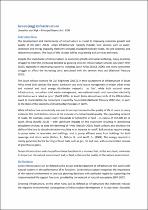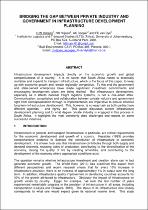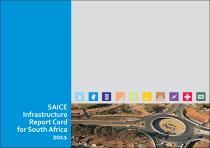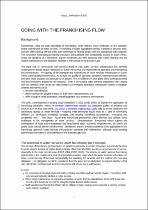JavaScript is disabled for your browser. Some features of this site may not work without it.
- ResearchSpace
- →
- Research Publications/Outputs
- →
- Conference Publications
- →
- View Item
| dc.contributor.author |
Van Wyk, Llewellyn V

|
|
| dc.date.accessioned | 2015-02-09T07:31:26Z | |
| dc.date.available | 2015-02-09T07:31:26Z | |
| dc.date.issued | 2014-10 | |
| dc.identifier.citation | Van Wyk, L. 2014. Greening infrastructure. In: The Sustainable Infrastructure Handbook South Africa Volume 1, The Essential Guide. Alive2green: Cape Town, South Africa | en_US |
| dc.identifier.uri | http://hdl.handle.net/10204/7864 | |
| dc.description | Copyright: Alive2green, Cape Town, South Africa | en_US |
| dc.description.abstract | The development and maintenance of infrastructure is crucial to improving economic growth and quality of life (WEF 2013). Urban infrastructure typically includes bulk services such as water, sanitation and energy (typically electricity and gas), transport (typically roads, rail and airports), and telecommunications. The focus of this chapter will be on greening bulk services and roads. Despite the importance of infrastructure to economic growth and social wellbeing, many countries struggle to meet the increasing demand by growing cities for infrastructure services (ULI 2007; WEF 2013), especially in developing countries including South Africa (SAICE 2006), and many consumers struggle to afford the increasing costs associated with the services they use (National Treasury 2012). The South African Institute for Civil Engineers (SAICE), in their assessment of infrastructure in South Africa rated bulk services like water, sanitation and solid waste management in major urban areas and national and local energy distribution networks as ‘fair’, while bulk national water infrastructure, non-urban solid waste management, non-national roads, and non-urban electricity distribution were rated as ‘poor’ (SAICE 2006). In South Africa almost two-thirds of the R76.6-billion owed to municipalities by consumers is owed by households (National Treasury 2012) due, in part, to the state of the economy and substantial increases in tariffs. While infrastructure undoubtedly can lead to an improvement in the quality of life of users, in many instances this contribution comes at the expense of environmental quality. The expanding network of roads, for example, covers many thousands of kilometres of land – in excess of 747,000 km in South Africa (SAInfo 2013) – with significant impacts on the ecosystem resulting in diminishing ecosystem services, as does the damming of rivers (McCully 2001). Road surfaces also decrease the ability of the land to absorb rain water resulting in an increase in runoff. Bulk services require energy to pump water to reservoirs and buildings, and to pump effluent away from buildings for both sewerage and storm water (Cohen, R., Nelson, B., and Wolff, G., (2004). The energy required is mainly generated by the burning of fossil fuels such as gas, oil, and coal, with a concomitant release of greenhouse gases. Green infrastructure seeks to perform those functions in a manner that, at the very least, minimises its impact on the natural environment and, at best, enhances the quality of the natural environment. | en_US |
| dc.language.iso | en | en_US |
| dc.publisher | Alive2Green | en_US |
| dc.relation.ispartofseries | Workflow;14130 | |
| dc.subject | Infrastructure maintenance | en_US |
| dc.subject | Infrastructure development | en_US |
| dc.subject | Sustainable infrastructure | en_US |
| dc.subject | Social wellbeing | en_US |
| dc.subject | Quality of life | en_US |
| dc.subject | Biodiversity | en_US |
| dc.subject | Greening infrastructure | en_US |
| dc.subject | Bioinflitration | en_US |
| dc.subject | Blue space | en_US |
| dc.subject | Ecology | en_US |
| dc.subject | Ecosystems | en_US |
| dc.title | Greening infrastructure | en_US |
| dc.type | Conference Presentation | en_US |
| dc.identifier.apacitation | Van Wyk, L. V. (2014). Greening infrastructure. Alive2Green. http://hdl.handle.net/10204/7864 | en_ZA |
| dc.identifier.chicagocitation | Van Wyk, Llewellyn V. "Greening infrastructure." (2014): http://hdl.handle.net/10204/7864 | en_ZA |
| dc.identifier.vancouvercitation | Van Wyk LV, Greening infrastructure; Alive2Green; 2014. http://hdl.handle.net/10204/7864 . | en_ZA |
| dc.identifier.ris | TY - Conference Presentation AU - Van Wyk, Llewellyn V AB - The development and maintenance of infrastructure is crucial to improving economic growth and quality of life (WEF 2013). Urban infrastructure typically includes bulk services such as water, sanitation and energy (typically electricity and gas), transport (typically roads, rail and airports), and telecommunications. The focus of this chapter will be on greening bulk services and roads. Despite the importance of infrastructure to economic growth and social wellbeing, many countries struggle to meet the increasing demand by growing cities for infrastructure services (ULI 2007; WEF 2013), especially in developing countries including South Africa (SAICE 2006), and many consumers struggle to afford the increasing costs associated with the services they use (National Treasury 2012). The South African Institute for Civil Engineers (SAICE), in their assessment of infrastructure in South Africa rated bulk services like water, sanitation and solid waste management in major urban areas and national and local energy distribution networks as ‘fair’, while bulk national water infrastructure, non-urban solid waste management, non-national roads, and non-urban electricity distribution were rated as ‘poor’ (SAICE 2006). In South Africa almost two-thirds of the R76.6-billion owed to municipalities by consumers is owed by households (National Treasury 2012) due, in part, to the state of the economy and substantial increases in tariffs. While infrastructure undoubtedly can lead to an improvement in the quality of life of users, in many instances this contribution comes at the expense of environmental quality. The expanding network of roads, for example, covers many thousands of kilometres of land – in excess of 747,000 km in South Africa (SAInfo 2013) – with significant impacts on the ecosystem resulting in diminishing ecosystem services, as does the damming of rivers (McCully 2001). Road surfaces also decrease the ability of the land to absorb rain water resulting in an increase in runoff. Bulk services require energy to pump water to reservoirs and buildings, and to pump effluent away from buildings for both sewerage and storm water (Cohen, R., Nelson, B., and Wolff, G., (2004). The energy required is mainly generated by the burning of fossil fuels such as gas, oil, and coal, with a concomitant release of greenhouse gases. Green infrastructure seeks to perform those functions in a manner that, at the very least, minimises its impact on the natural environment and, at best, enhances the quality of the natural environment. DA - 2014-10 DB - ResearchSpace DP - CSIR KW - Infrastructure maintenance KW - Infrastructure development KW - Sustainable infrastructure KW - Social wellbeing KW - Quality of life KW - Biodiversity KW - Greening infrastructure KW - Bioinflitration KW - Blue space KW - Ecology KW - Ecosystems LK - https://researchspace.csir.co.za PY - 2014 T1 - Greening infrastructure TI - Greening infrastructure UR - http://hdl.handle.net/10204/7864 ER - | en_ZA |









